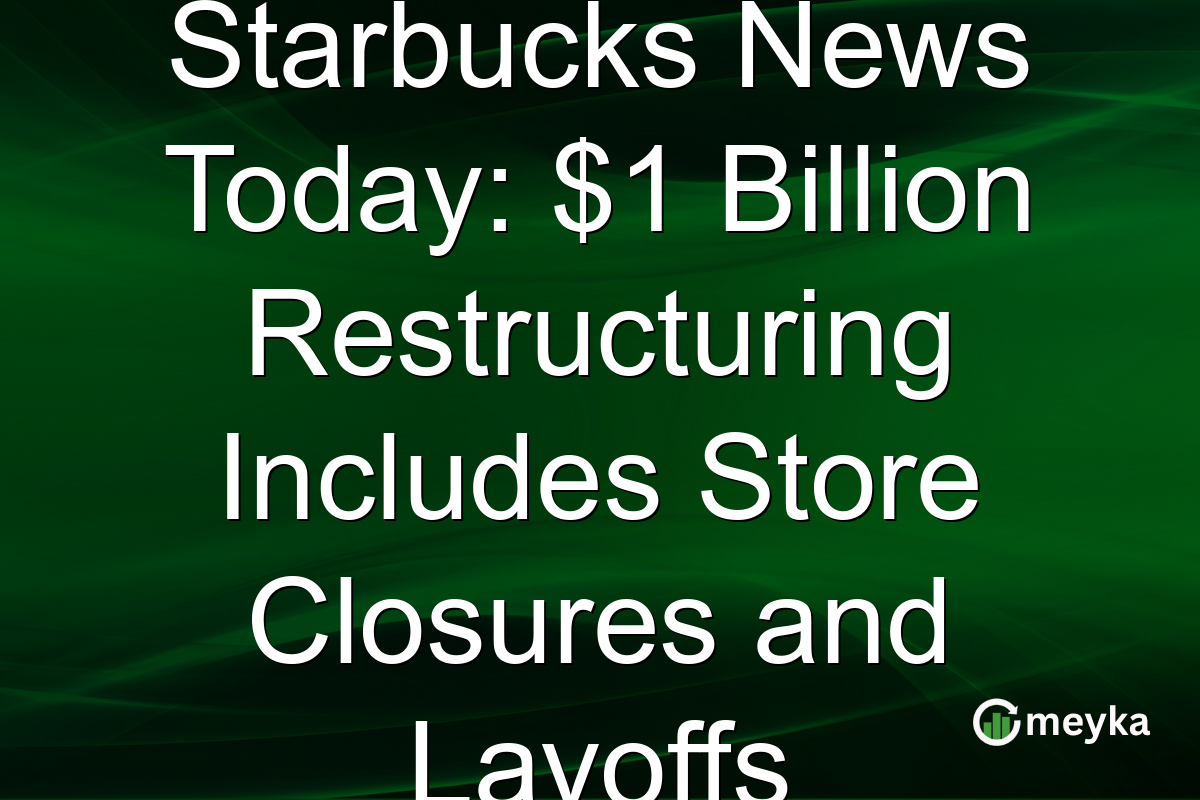Starbucks News Today: $1 Billion Restructuring Includes Store Closures and Layoffs
Starbucks has unveiled a $1 billion restructuring plan aimed at revitalizing its operations amidst declining sales. This initiative will result in the closure of underperforming stores and the layoff of approximately 900 non-retail employees. With Starbucks stock (SBUX) falling by 0.5% recently, these strategic moves are designed to streamline operations and boost financial performance. The company’s aggressive steps highlight the challenges in a competitive market and its commitment to long-term growth. Let’s delve into what this restructuring means for investors and the broader business landscape.
The Rationale Behind Starbucks Store Closures
Starbucks’ decision to close underperforming stores forms a crucial part of its restructuring strategy. By focusing on locations with higher growth potential, the company aims to enhance profitability. The closures are expected to free up resources that can be redirected towards expanding digital capabilities and optimizing operational efficiency. Additionally, the shift aligns with evolving consumer preferences, particularly the increasing demand for online and mobile services. Despite these closures, Starbucks continues to explore growth opportunities in emerging markets. The restructuring plan considers regional market dynamics, ensuring that resources are allocated to areas with robust demand. The company’s proactive approach underscores its adaptability in a rapidly changing industry. For investors, these strategic closures suggest a targeted focus on regions offering better returns and growth prospects. Read more on Axios.
Impact of Starbucks Layoffs on Operations
The planned layoffs primarily involve non-retail positions, reflecting Starbucks’ goal to streamline its corporate structure. With around 900 positions affected, the company aims to eliminate redundancies and enhance efficiency. These measures are part of a broader effort to reduce operational costs and reinvest savings into customer-facing initiatives. While layoffs are often difficult, Starbucks is focusing on maintaining its renowned customer service and product quality. By prioritizing strategic roles and initiatives, Starbucks ensures that it remains agile in responding to market changes. For investors, this move illustrates Starbucks’ commitment to sustainable growth, potentially leading to increased shareholder value in the long run.
Market Reaction and Financial Implications
Starbucks stock (SBUX) has seen a modest decline, reflecting market reactions to the restructuring announcement. Trading at $83.39, the stock is down 0.52% with a recent 1D change of -4.60%. Analysts continue to recommend a hold, with 17 rating it as a buy and 13 suggesting a hold. The market’s cautious approach underscores the uncertainties surrounding the restructuring’s impact on future earnings. This restructuring is expected to positively influence Starbucks’ operational costs and eventually improve margins. Looking ahead, the focus on profitable store locations and enhanced digital presence may drive long-term performance. Investors should watch for the upcoming earnings announcement on October 28, 2025, for detailed insights into how these changes are affecting Starbucks’ bottom line. Track SBUX stock.
Strategic Outlook and Investor Takeaways
Starbucks’ restructuring signals a strategic pivot essential for navigating a competitive landscape. By closing non-performing stores and streamlining corporate functions, Starbucks aims to optimize its existing resources. This thoughtful redeployment is expected to enhance its competitive edge. For investors, the restructuring provides an opportunity to reassess Starbucks’ long-term growth trajectory. The commitment to digital innovation, paired with a focus on core store models, is likely to bolster customer engagement and financial performance. As Starbucks continues its transformation, investors should consider the potential benefits of a leaner, more agile company in their portfolio strategies.
Final Thoughts
Starbucks’ announcement of store closures and layoffs marks a pivotal moment in its corporate strategy. The $1 billion restructuring plan is a bold step towards addressing declining sales and ensuring long-term viability in a competitive market. While some short-term uncertainties remain, the focus on high-performing stores and digital expansion provides a clearer path to recovery. For investors, this restructuring offers a chance to evaluate Starbucks’ future potential. The emphasis on operational efficiency, combined with strategic reinvestments, reflects a strong commitment to sustaining growth. Keeping an eye on Starbucks’ performance post-restructuring will be crucial as it seeks to navigate industry challenges successfully. Advancements through platforms like Meyka can offer AI-driven insights to investors tracking such dynamic changes. Use this period to make informed decisions that align with both immediate and long-term investment goals.
FAQs
Starbucks is closing underperforming stores as part of a $1 billion restructuring plan. This strategy allows Starbucks to focus resources on profitable locations and enhance operational efficiencies, responding to market demand shifts and competitive pressures.
The layoffs affect around 900 non-retail employees, aimed at streamlining operations and reducing costs. Starbucks intends to maintain its service standards while reallocating savings to enhance customer experience and strengthen its core functions.
Starbucks stock (SBUX) is currently trading at $83.39, having fallen by 0.52%. Analysts generally recommend holding SBUX, with mixed forecasts reflecting uncertainties in the restructuring impact.
Analysts view the restructuring as a necessary step to address operational inefficiencies and declining sales. With mixed ratings of buy and hold, analysts suggest that the outcomes of these changes will determine future adjustments in stock valuation.
The restructuring aligns with Starbucks’ long-term goals of enhancing digital capabilities and focusing on profitable markets. It’s a strategic move to improve customer experience and financial performance, reflecting adaptability to evolving industry trends.
Disclaimer:
This is for information only, not financial advice. Always do your research.






